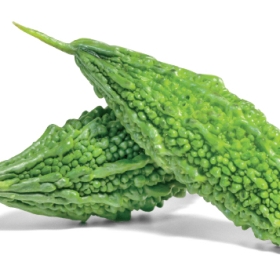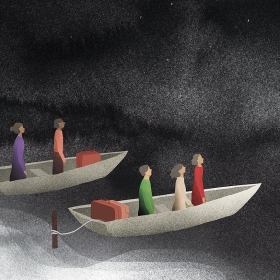In a New York City neighborhood, Chinese, Greek, Korean, and Salvadoran families grow plants to get a little closer to the flavors of home. Even when surrounded by asphalt, concrete, and steel, the families continue to garden; they nurture local soil, and they build local culture—as does writer Esther Kim ’12, dreaming of Taiwan.

Outside my apartment in Flushing, Queens, N.Y., the late morning sun blazes. With the windows shut, I gulp cool barley tea and guiltily blast my air conditioner to counter yet another heat wave, a smothering reminder of our climate crisis. My phone buzzes with a text: “I slep.”
Time to call my partner in Taiwan before he goes to bed. Pandemic restrictions mean that I haven’t seen him in person for two years, and our long-distance relationship depends on rare earth minerals and lithium. That is to say, our phones. After I wish him a good night, I step outside onto the radiant concrete pavements to survey the neighborhood’s gardens.
I love Flushing. I gush about this neighborhood to every friend, family member, Twitter follower, and distant relation. I see Chinese, Greek, Korean, and Salvadoran families grow plants here to get a little closer to the flavors of home. Even when surrounded by asphalt, concrete, and steel, the families continue to garden; they nurture local soil, and they build local culture.
Behind chain-link fences, they grow waist-high annuals like bright gold sulphur cosmos and swan river daisies; they cultivate 苦瓜 bitter melons (pictured above), tomatoes, chili peppers, green grapes, and pendulous watermelons on the tiny rectangles of land by their homes that escaped paving. I’m amused to find ripe watermelons dangling over a minivan, swaddled like babies as they hang in supportive slings, tied to DIY pergolas.
Babies. Someday? The last time I stayed at my partner’s home, then in Malaysia, was two years ago. A prolific 芒果樹 mango tree grows, transplanted there by his uncle as a housewarming gift that keeps giving. We once woke up together to raucous birdsong in Malaysia; I now wake to play his phone’s audio recordings of the birds in Taiwan, and he the birds in New York. But I’m comforted by the thought that while we’re apart, the old mango tree grows outside his childhood home, and his mother continues to wrap each ripening fruit in newspaper to discourage the birds, monkeys, and sneaky motorcyclists from plucking them.
Two years ago. To stay connected, we share nature updates from the daily walks through our cities.
For example, he came across two “celebrity” geese in a park not far from his apartment. 奇奇 and 凡凡. These elegant white geese with black beaks (Anser cygnoides) strut along the green and greet their picnicking human subjects. One day, he sends a screenshot of an article, “Geese: A Lesson in Family Values.” Then comes a photo. (“Look at this classical painting of a Confucian scholar surrounded by a gaggle.”)
As I walk toward the train station, I pass a young fig tree planted in the median strip between asphalt road and concrete sidewalk. Its curvy leaves are wrapped in plastic orange safety fencing. I think of paintings of Adam and Eve using fig leaves to conceal their nakedness, aware and ashamed of it for the first time after they’re ejected from Eden. Now here we are wrapping fig leaves in plastic …
The streets in this neighborhood are named after plants and ordered alphabetically from Ash Avenue in the north to Rose Avenue in the south. I learn later that Flushing was the site of the first commercial tree nurseries in North America in the 1730s and supplied trees to Thomas Jefferson’s Monticello as well as New York City’s Central Park. I continue my walk toward Ash.
Halfway there, I stop to admire my favorite house, painted yellow, where an elderly Filipino couple grow white and red hibiscus (swamp rose mallow) the size of dinner plates. Their front garden is informal and well-tended, an exuberant mix of flowers, vegetables, and fruits growing in full sun in containers. Behind the showy mallows, I spy a persimmon tree, a towering clump of blackberries, and fuchsia globe amaranths electric against vigorous green peppers and tomatoes. Hello, a migratory monarch butterfly! I snap a photograph for my partner.
Our text messages—observations of our natural surroundings, urban gardens, and large birds—are our lifelines during a lonely season. Such small acts may seem insignificant, but how else can we nourish ourselves during this perma-crisis if not with our daily routines? How else can we connect through the touchless digital world if not with the embodied natural?
Farmer-poet Wendell Berry reminds us, “The real work of planet-saving will be small, humble, and humbling, and (insofar as it involves love) pleasing and rewarding.” So we check the Climate Clock, walk outside, and document our corners of the world; we observe the strong green growth and attendant birds, dreaming up the wee garden we will soon sow together in Taiwan from seeds.
Esther Kim ’12 is a writer and former book publicist who is plotting her move to Taiwan and planting Asian heirloom seeds of cucumbers, gochu, and kkaenip in her garden on Long Island. More of her writing is available at estheryk.com.


